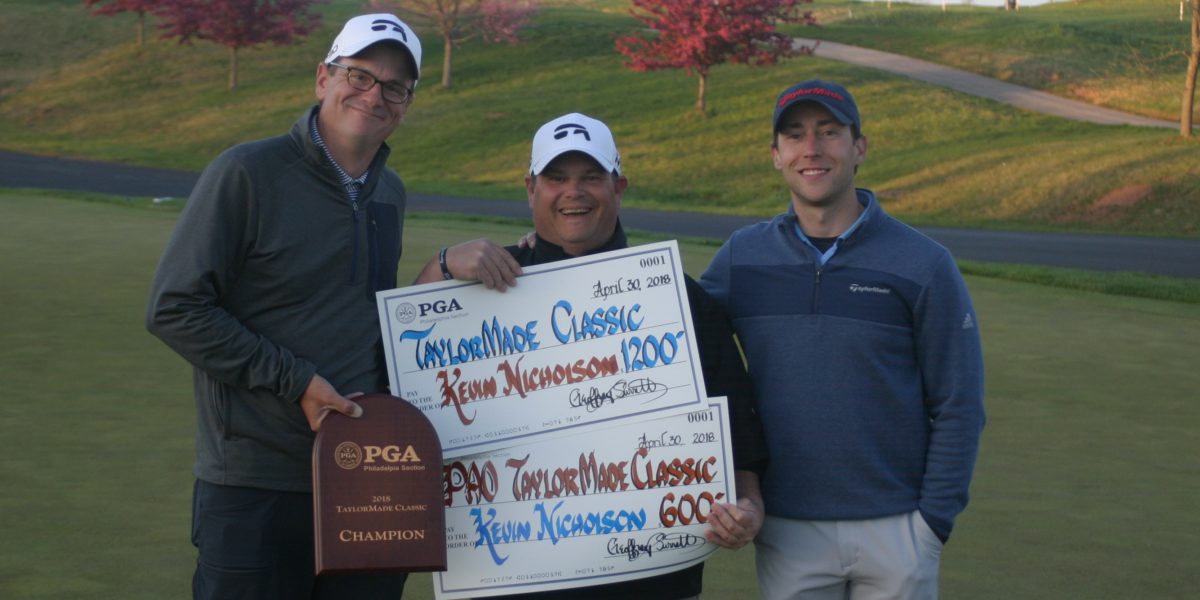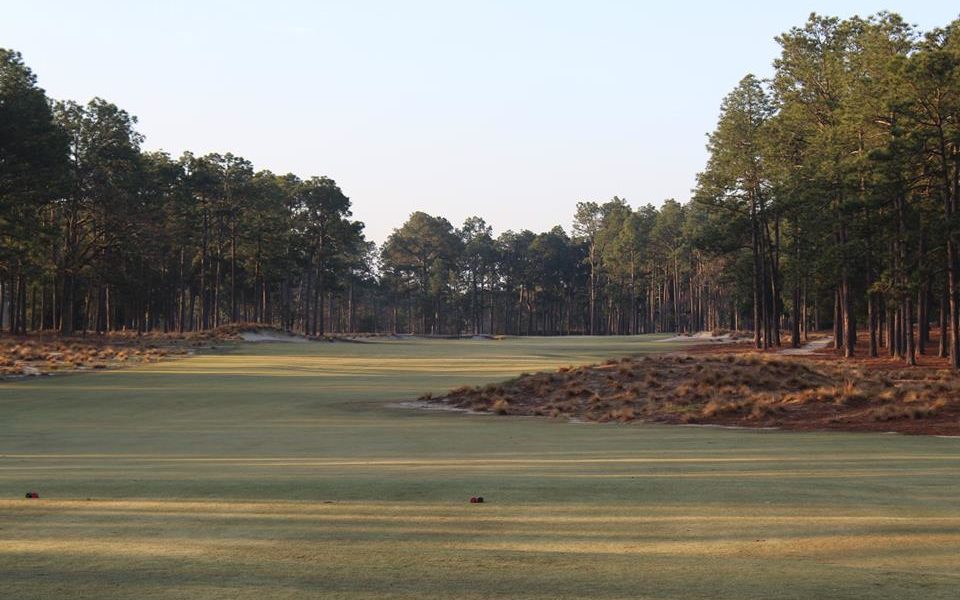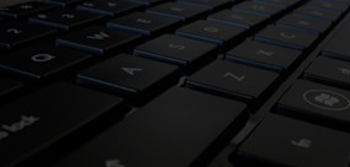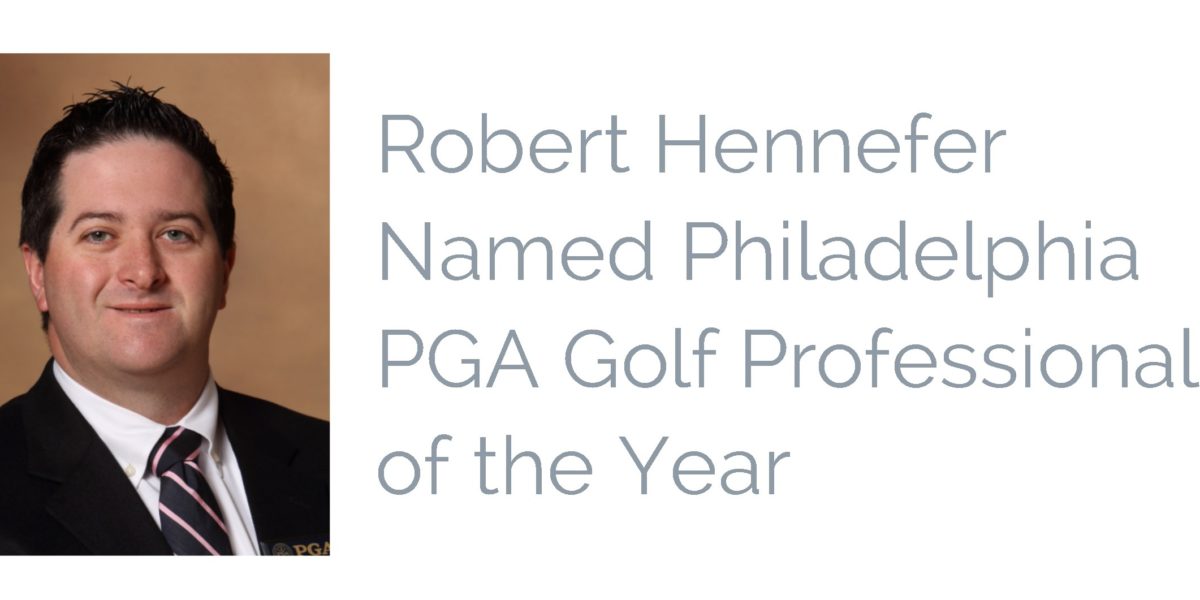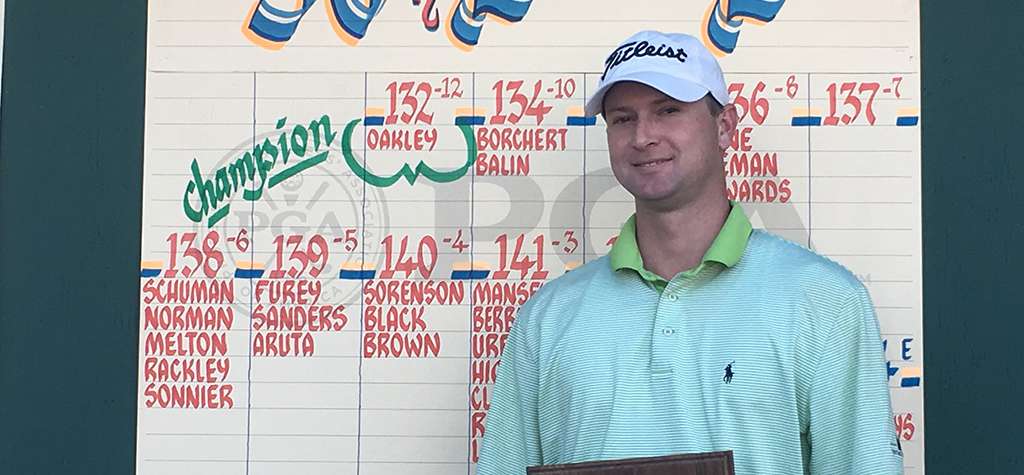Download Full Special Awards Release
In early December, the Philadelphia PGA’s Special Awards Committee met with a singular goal in mind of determining the 2017 Philadelphia PGA special awards. With more than 140 Philadelphia PGA Professionals nominated for awards this past season, the task of narrowing the nominees down to the top professional in each category would be extensive. However, after lengthy deliberation, the committee recognized ten professionals with the following awards.
GOLF PROFESSIONAL OF THE YEAR
The highest recognition the Philadelphia PGA bestows annually is the Golf Professional of the Year award. This year that achievement goes to Robert Hennefer, the Director of Golf at Indian Spring Golf Club. Since obtaining his membership in 2008, Hennefer has held multiple Head Professional, Director of Golf, and General Manager positions before arriving at Indian Spring Golf Club in 2014.
Since taking over operations at the township owned facility, Hennefer and his team have increased Indian Spring’s rounds of golf, driving range sales, merchandise sales, and memberships all leading to an overall revenue increase each of the past three seasons. Because of the success of the facility and the township’s eagerness to improve their parks and recreation program, Hennefer has been appointed to oversee the township’s new Recreation and Open Space Initiative.
However, Hennefer does not limit himself to just succeed at his facility. Since becoming a PGA member, Hennefer has served on multiple Philadelphia PGA committees as well as board positions. Most recently, Hennefer ended his term as the Section’s District 1 Director and was elected to serve on the Executive Committee as Director of Tournaments.
Hennefer also gives his time as a volunteer and mentor to his fellow PGA Professionals. Hennefer has volunteered to provide free lessons at various Section and community events, often times seeking out opportunities to bring the game of golf to new audiences. Having been mentored by some of the Section’s most well-known Professionals, Hennefer repays those experiences by talking with young apprentices and PGM students preparing for their Playing Ability Test.
Although it is Hennefer’s work with individuals with special needs that has rewarded him the most. Inspired by his brother Brad, Hennefer has dedicated countless hours to working with individuals with Down Syndrome. This includes community walks, golf lessons and competing in the Special Olympics alongside his brother. It is because of this dedication that Hennefer received the Special Olympics’ highest honor, the Conrad Rehling Award in 2016. Golf Professional of the Year is Hennefer’s third Philadelphia PGA special award (Player Development – 2012), (Merchandiser of the Year – Public 2015).
“I am extremely honored, excited and humbled to be recognized as the Golf Professional of the Year, said Hennefer. There are many great PGA professionals in the Philadelphia section and I am truly honored to be recognized among them.”
“I am grateful for the great team at Indian Spring that I am lucky enough to work with every day as well as for my wife Diana who has supported me throughout my career. This for me, is an award I will cherish forever, but it is also special for our facility to be recognized, and that is what I am really excited about.”
“A special thank you to the special awards committee and the Philadelphia PGA staff for all of the hard work they put in on a daily basis. A heartfelt congratulations to all of the other award winners and I look forward to celebrating with everyone at our annual awards dinner.”
TEACHER OF THE YEAR
Receiving this year’s Teacher of the Year honor is a two-time past winner (2008, 2015), John Dunigan of White Manor Country Club. Dunigan has been a fixture on the teaching scene having presented at multiple seminars nationally, locally as well as internationally at the First Modern Golf Coaching Summit in Manilla, Philippines. Although teaching junior golfers is the biggest segment of Dunigan’s portfolio he also teaches accomplished golfers of all levels. Perhaps the biggest name on Dunigan’s roster is PGA Tour veteran Sean O’Hair who Dunigan has coached since 2013. In addition to teaching, Dunigan has published many articles aimed at teaching and coaching. Not only has Dunigan been a three time Philadelphia PGA Teacher of the Year, he has also been recognized as a Golf Digest Top 50 Teacher (2017), Golf Magazine Top 100 Teacher (2016), Golf Range Magazine Top 50 Teacher (2015-2016) and a US Kids Top 50 Instructor (2013-2014).
“We have such a large number of great teachers in our section that being named Philadelphia Section Teacher of the Year is a major career achievement, said Dunigan. To receive this award for a third time leaves me speechless–and if you know me, that’s saying quite a lot. I would like to thank Concert Golf and the fine folks at White Manor CC for giving me the opportunity to be part of a great team and make myself truly at home at their wonderful facility. I’d like to thank the awards committee for their hard work on the arduous task of choosing the award winners from such a great talent pool. Most of all, I would like to thank my students: you are the reason why I study every single day to make myself a better coach for YOU. This award is every bit as much yours as it is mine.”
ASSISTANT GOLF PROFESSIONAL OF THE YEAR
The Philadelphia PGA Assistant Professional of the year was awarded to Dan Mrozinski of Commonwealth National Golf Club. In addition to serving all of the roles required of an Assistant Professional at Commonwealth National, Mrozinski also finds time to serve the Philadelphia PGA as a member of the Section’s Junior Golf Committee. It is through his involvement on this committee that Mrozinski has been able to implement a variety of PGA of America initiatives at Commonwealth National, most notably PGA Junior League Golf. Mrozinski also stays involved in his local community serving as a member of the Deerhurst Civic Association helping to plan and organize various community events. This is Mrozinski’s first Philadelphia PGA special award.
“Winning this award means so much me it’s difficult to put into words, said Mrozinski. I’m extremely honored to be the recipient and humbly except this award on the behalf of all the hard working Assistants in the Section.
I would like to thank Patrick Shine for his mentoring, his guidance and nomination. I also have to thank the entire Commonwealth family for all the support.”
HORTON SMITH AWARD
This year’s Horton Smith Award was presented to Eric Handley of Penn State University. Handley serves as the Director of Penn State University’s Teaching and Research Center in addition to serving as an assistant professor in the University’s PGA Golf Management program. Over the past five years, Handley has been committed to sharing the information he and his team are working on at Penn State with his fellow professionals both locally and nationally. Handley, has presented at the PGA of America’s Merchandise Show the past three years including as a keynote speaker at the 2017 Teaching and Coaching Summit. Handley has also been instrumental on the Philadelphia PGA education scene presenting on various Biomechanic topics. As an assistant professor, Handley has created a curriculum for a web-based Biomechanics of Golf class which is available to anyone with an internet connection. Handley also works closely with the University’s PGM program to develop initiatives for the Penn State PGM Player Development program. This is Handley’s first Philadelphia PGA special award.
“Being recognized as the Horton Smith award recipient has great significance and is particularly special to me, said Handley. Within the Penn State PGA Golf Management program we are particularly passionate about contributing to the education of future and current PGA Professionals. I owe much of this recognition to the support of family, friends, and the amazing people with whom I work.”
PGA BILL STRAUSBAUGH AWARD
This year’s PGA Bill Strausbaugh Award was presented to Tom Gilbert of Gulph Mills Golf Club. The Strausbaugh Award recognizes an individual for their continuing effort to mentor their fellow PGA Professionals. This trait is evident in Gilbert as he has helped nearly all of his past Assistant PGA Professionals to further their careers and obtain Head Professional positions. Gilbert has also worked to cultivate a strong network of PGM interns through his relations with several PGM universities. Gilbert not only dedicates his time to helping those assistants who he works with but also to various organizations outside of the Gulph Mills community. Gilbert has volunteered at the Ronald McDonald House, the Cradles to Crayon charity in Conshohocken, and the Mid-Atlantic Blind Golfers Association. This is Gilbert’s second Philadelphia PGA special award (Merchandiser of the Year – Private 2016).
“I am incredibly honored to have won the Bill Strausbaugh award, said Gilbert. Over the years my staff has helped me become a successful Professional and in return, I try my best to help them reach their career goals. I am thrilled to be the person receiving this year’s award, but in my mind it is a representation of all of my assistants success and for that I am truly proud.”
PLAYER DEVELOPMENT AWARD
Gerry Davis of Flourtown Country Club was presented with the Player Development Award for the 2017 season. Davis is active in player development both at Flourtown Country Club as well as away from the facility. At Flourtown Country Club, Davis has implemented a variety of programs for golfers of all abilities all aimed at getting people involved in the game. These programs include “Golf at the Pool” a programs which brings golf to Flourtown’s more than 1200 pool members. This initiative has directly led to new golf members each of the past three years. Davis also has a variety of programs aimed at introducing, teaching and retaining female golfers. Finally, Davis has been instrumental in growing Flourtown’s PGA Junior League Golf since 2014. This is Davis’ first Philadelphia PGA special award.
“I am truly honored and humbled to have been awarded the 2017 Player Development Award for the Philadelphia Section PGA, said Davis. Growing the game is a passion of mine every day. It’s a joy to teach new players, both young and old. I’m grateful to Bob Hennefer, PGA of Indian Spring Country Club for nominating me and to the Special Awards Committee for this award.”
YOUTH PLAYER DEVELOPMENT AWARD
This year’s Philadelphia PGA Youth Player Development Award was presented to Dave Zimmaro, Assistant PGA Professional at Overbrook Golf Club. Since arriving at Overbrook Golf Club, Zimmaro has worked diligently to incorporate all of the PGA of America initiatives at the facility. These include Drive, Chip, and Putt, PGA Junior League Golf as well as the Philadelphia Junior Tour. However, Zimmaro’s reach into Youth Player Development extends well beyond that. Beginning with his time at the First Tee of Greater Philadelphia, Zimmaro has worked to bring golf to those who may have not had access to the game previously. This includes a golf in schools program, working with the Mid-Atlantic Blind Golfers Association, learning sign language in order to work with students at the Pennsylvania School for the Deaf, and working with the Department of Justice on the Students for Juvenile Justice (SJJ) initiative. The SJJ works as a rehabilitation program giving juveniles a chance to learn the game of golf. These are just a few of the programs Zimmaro has worked with during his time as a PGA Professional. This is Zimmaro’s first Philadelphia PGA special award.
“I am very humbled and honored to accept the 2017 Youth Player Development Award, said Zimmaro. I accept this award on behalf of all the PGA Professionals whose tireless work positively impacts the lives of youth through the game of golf. It truly takes a village to run a successful youth program. Thanks to all of the people who have helped me along the way, but most importantly to the kids who inspire me to work harder every day!”
PATRIOTS AWARD
The PGA Patriot Award recognizes a PGA Professional who personifies patriotism through the game of golf and demonstrates unwavering commitment to the men and women who have served in our nation’s military. This year, the Philadelphia PGA recognizes John Carpineta of Bensalem Township Country Club as the recipient of this award. Carpineta’s journey to become a PGA Professional did not come until after a few stops along the way, included serving in our nation’s military. However, once Carpineta became a PGA Professional he began to serve our military veterans in a variety of ways. Carpineta has been a leader in growing the Philadelphia PGA’s HOPE (Helping Our Patriots Everywhere) program through his connections with the area VA centers and VFW halls. Carpineta has also been activate with the Eastern Amputee Golf Association, Wounded Warriors Program, VA First Swing Clinic, and Patriot Golf Day events. This is Carpineta’s second Philadelphia PGA special award (Player Development Award – 2015).
“I am deeply honored to be chosen for this award considering the number of many fine PGA Professionals in our Section, said Carpineta. A big thank you goes out to the committee who work hard to make their selections. I must however in good conscious share it with those who contribute so much to the HOPE program which this year impacted more than 1,200 veterans getting them back into the swing of things not only on the links but also at home. Let there be no mistake these 1,200 veterans will be in contact with their fellow veterans who feel there is no hope thus enabling them to remain on our planet receiving the love they deserve.”
MERCHANDISER OF THE YEAR (PRIVATE)
This year’s Merchandiser of the Year – Private was awarded to Commonwealth National Golf Club’s Patrick Shine. Under the direction of Shine the golf shop at Commonwealth National has seen steady growth over the last several years. Understanding the needs and wants of the membership, Shine and his team work keep to the golf shop fresh in part by updating displays twice monthly giving the golf shop a “life-style shop” feel. Additionally, Shine has utilized an indoor teaching center and technology to increase hard good sales at Commonwealth national. Although previously nominated, this is Shine’s first Philadelphia PGA special award.
“First, I’d like to congratulate all the Special award winners, said Shine. Being part of the special awards committee for the last couple of years has allowed me to see just how much talent we have in the Philadelphia PGA. We are truly fortunate to have some of the PGA’s finest teachers, players, educators and community leaders in our Section.”
“To be recognized by my peers for Merchandising is special. This award, unlike some of the other categories is a complete team award. I am fortunate to work with a staff that prioritizes the merchandising aspect as one of the club’s top priorities. The combined daily efforts of Dan Mrozinski, Bill Fromholzer, Justin Rinas along with Nadine Stan-Boyens has been crucial to hitting our sales goals. I certainly would not have received this award without their hard work and dedication. Lastly, I am thankful to our membership at Commonwealth for their continued support and trust when purchasing apparel and golf equipment.”
SALESPERSON OF THE YEAR
The final Philadelphia PGA special award was presented to our Salesperson of the Year, Jim Ravina. As an independent sales representative, Ravina has supported the Philadelphia PGA across multiple brands for nearly thirty years. Ravina has also helped to educate our PGA Professionals through in-shop seminars on merchandising and technology. Ravina’s dedication to our Section Professionals is a big reason why he is a two-time Philadelphia PGA Salesperson of the Year (2014, 2017).
“The Philadelphia PGA is stacked with talented sales representatives, said Ravina. I am honored and humbled that I was chosen as the 2017 Philadelphia PGA Salesperson of the Year. I would like to offer my sincerest gratitude to all of the PGA Professionals who gave me the opportunity to serve them over the past 30 years. Being recognized by your customer is the highest honor a sales person can hope to achieve. On behalf of all of the companies I represent, my assistant Ann Ohmott and myself I wish to thank the entire Philadelphia PGA for this most prestigious award.”

